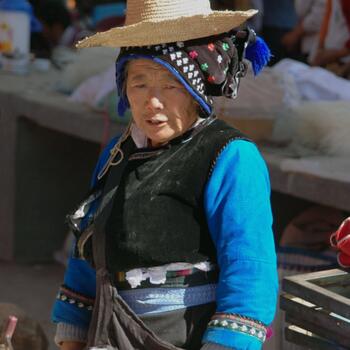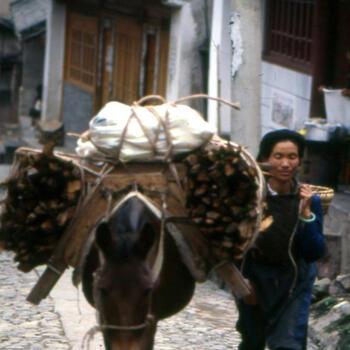Quick Menu
Before highways seriously began linking up various parts of Yunnan in the late twentieth century, and trucks started delivering goods everywhere, caravans were the means to carry out long-distance trade. While they plied trails on traditional routes connecting all parts of the province, the most important was the famous Tea Horse Road. It ran from Xishuangbanna in the south, through western and northwestern Yunnan and into Tibet. Its name derived from its principal trade items — Pu'er tea from southern Yunnan and horses from Tibet.
Many towns along the route became popular stopovers for the caravans, providing lodging and places to tether and feed the animals. Among these was Shaxi (沙溪), in Jianchuan County (剑川县), a part of northern Dali Prefecture. The usual way to get there was proceeding north from the city of Xiaguan (下关) at the south end of Erhai Lake (洱海). The route wove past the Azure Mountains — called Cangshan (苍山) in Chinese — on the west side, then out of the valley, through Eryuan County (洱源) to Sword Lake (剑湖), just south of the town of Jianchuan.

Getting to know Shaxi
At the junction here a road turns south-southwest along the Heihui River (黑惠江), which empties into Sword Lake. The small lake sits on a broad plain dominated by the town of Shaxi. Never very big, the village was nevertheless fairly prosperous until the virtual end of the caravan trade after 1949. Yet in its slow modernization over the next several decades, Shaxi still retained its old quarter of cobbled lanes and traditional Bai minority houses. These former lodges for the caravan operators sat side-by-side with dilapidated but not destroyed temples and other ornate public buildings. It was the last of the caravan stopovers that still looked like one.
Shaxi is basically a farmers' town. But from the beginning of the twenty-first century it took on a new identity as a popular tourist attraction. The provincial government launched restoration programs, renovating the old temples and the gorgeous theater on the market square.
The town was promoted for its historic connection to the Tea Horse Road. The settlement now has a new section of boring concrete buildings, but this quarter is a minor part of Shaxi and such 'modern' architecture doesn't appear in the traditional part of town. New houses have gone up, but in the classic traditional Bai style.

The town sits on the west bank of the river and just a little above the water. Two bridges cross the Heihui. One is for pedestrians, centuries old, a classic arched stone bridge with sculpted lion heads at each end and on the side over the highest point of the arch. The other, for vehicles, is an ordinary level bridge in the 1950's style, with elliptical arches and plain columns at each end. It looks out of synch with all the old-fashioned buildings within sight in every direction. But at least it is outside the town proper, where the traditional look has not only survived, but been enhanced.
The population of Shaxi is a mixture of people from the Han, Hui and Bai ethnic groups. Most of the old houses are mud brick with tiled roofs. Others, like the former boarding houses for caravan drivers, are mainly wooden. Some of the richer Bai live in houses with carved gates with painted decorations under the apex of the roofs, much like those in Dali (大理) or Jianchuan. Shade trees line the main streets in the old town and trimmed shrubs sit in pots in front of the houses. Passageways through the lanes pass under the arches of neighborhood gates, or of houses that straddle both sides of the alleys.
A quiet, almost sedate atmosphere once prevailed in the old town, where vehicular traffic was basically absent, except for bicycles and the occasional tractor-trailer. That all changes on Fridays, Shaxi's market days. Residents of the town, joined by villagers from the vicinity, set up stalls in the old market square and along practically all the lanes in the old town. The local dentist has an outdoor stall that day, too.

Products on sale vary considerably. One section will feature carved door and window frames or chairs and stools. Another will feature all kinds of carrying baskets, while yet another will be hawking tools and horse tackle. One lane will fill with grains, spices, vegetables and fruits, and the next one will offer shoes and clothing. There will be noodle stalls for those who want lunch and steamed buns and other snacks available at small stands. Electronics and vendors who can repair them have moved in as well.
Market day draws the valley's Han and Bai, but also many Yi people from the mountains, as well as a few Lisu, Naxi and perhaps itinerant Tibetans selling medicinal herbs. The Yi are the same Nuosu branch that dominates Ninglang County to the north. Yi women are the most colorful people in the market, with long, bright, tri-colored skirts, decorative jackets and either a large, black rectangular hat or a flat, embroidered cloth held in place by hair braids. If it's cool weather, the outfit includes a dark felted woolen cape.
In late afternoon, when villagers start returning home, leading ponies packed with their goods, the scene evokes the time of the Tea Horse Road. The caravan trade expanded from the tenth century during the Song dynasty, because the emperor's military forces needed horses to deal with enemies on its northern frontiers. Shaxi may have been a caravan stopover by then, though no relics exist from that long ago.

Nearby Shibaoshan (石宝山), however, is the site of religious monuments from the Nanzhao Kingdom, with stone carvings from around 800. Shibaoshan is a tall, steep hill in a wooded rural area, remarkable for the pagodas built into its cliffs and the grottos with stone sculptures. These date from the Nanzhao and Dali periods before the thirteenth century. They include a seated Buddha flanked by his two favorite disciples, a standing Guan Yin, various multi-armed deities and small Buddha images.
The most unusual is a stone vagina. Local women come here, especially when they get pregnant, to pray and to rub the stone. They believe this act will ease the pangs of childbirth. Shibaoshan is also host to the three-day Bai Singing Festival at the end of the seventh lunar month.
In the caravan heyday, Shaxi was a stopover for groups on the way to and from Tibet. Merchants might also pick up salt here from nearby mines. Going south, they needn't detour to Eryuan and Dali to reach Xiaguan, but could simply continue down the valley of the Heihui River over what used to be called the Bo'nan Road. The road is never very high above the river, nor does it cross any hills. Villages are visible in the flanking hills and all along the riverbanks.
The town of Yangbi
The road passes through western Eryuan County and the last village before entering Yangbi County (漾濞县) is Changyi (长邑), which holds its market day on Saturdays. Bai and Yi, as in Shaxi, are the main participants. Except for furniture, most items on sale are the same as in Shaxi, with the exception of walnuts, a specialty of Yangbi.
Yangbi is a Yi Autonomous County, with at least four Yi sub-groups living in the hills, which make up most of its territory. Until a generation ago, the Yi lived at a level of basic subsistence. Then the government introduced the planting of walnut trees. Yangbi is not the only place in Yunnan cultivating walnuts. Dayao (大姚县) and Gongshan (贡山县) counties also have them, for example. But the soil in Yangbi seemed to be particularly good for walnuts, producing a thin-shelled, tasty, slightly sweet nut. Soon after their introduction, Yangbi became dubbed the "hometown of walnuts."
Nowadays walnut plantations cover 71,000 hectares in the county. The annual output has reached 50,000 tons, valued at one billion yuan. Government statistics claim that as a result 70 percent of the county's population has been lifted out of poverty. Harvesting begins in September and, to coincide with it, the county government stages a month-long Walnut Festival in Yangbi City. Events include rites to the Walnut God, food-tasting events, cooking competitions, markets and rounds of singing and dancing performances.

As the caravan road crosses into Yangbi County, the towering peaks of the Azure Mountains rise to the east. In the caravan era, Yangbi — originally called Shangjie — was an important junction on the Bo'nan Road. Instead of going on to Xiaguan or north to Shaxi, caravans could turn west here to reach Yongping (永平) and Baoshan (保山). The city has a modern section of nondescript concrete and steel buildings around the city stadium, the main venue for festivals. But Yangbi also has an extensive old quarter, largely Hui-inhabited, full of traditional tile-roofed wooden houses. A fine old Chinese-style mosque sits on a mound above the old neighborhood.
Homes are not as elegant as some of the Shaxi dwellings and the cobbled lanes have not been renovated in recent years. But a walk through it is evocative of an earlier era. Continuing past the mosque, the lane terminates at the old Yunlong Bridge, the main river crossing for caravans going west.
A suspension bridge with wooden planks laid across iron cables dates from the early Qing Dynasty. The town doesn't have caravan traffic anymore, but the bridge is still in use by villagers living across the river. On the other side, earlier this century, Yangbi Han Buddhists erected a small Buddhist shrine and a pagoda above the span.

Xiaguan
From Yangbi City, the road swings southeast along the river, which here changes name to the same as the county. At its confluence near the village of Pingpo (平坡) with the Xi'er River, it flows east to Xiaguan and into Erhai Lake. The road swerves much closer to the Azure Mountains on this stretch. At Jinniu (金牛) is a steep cleft in the hills called Stone Gate Pass, now being built up as a scenic attraction with the construction of a walkway along the base of one of the cliffs. At Pingpo the road turns east along the Xi'er River, passing the southern end of the Cangshan range before gliding into Xiaguan.
Now the capital of Dali Prefecture and the biggest city in western Yunnan, Xiaguan began as an eighth century fortified settlement. It was founded by King Piluoge of the new state of Nanzhao to guard the southern entrance to the Dali plain. Taihe (太和), further north and established in 737, served as the Nanzhao capital until it was moved to Dali in 779. Xiaguan lies at the southwest corner of Erhai Lake, backed by high mountains with the suburbs of today sprawling into the foothills.
Over time it outgrew Dali and was a major stop for caravans heading north on the Tea Horse Road to Tibet, as well as the Southwest Silk Route to Dehong Prefecture and on to Burma and India. By the turn of the twentieth century, Xiaguan was also a major tea-processing center. Its commercial importance increased with the construction of the Burma Road during the Sino-Japanese War to enable the transport of supplies of all kinds from British-held Burma into Yunnan.

After the war and the foundation of the People's Republic, Xiaguan's growth and development expanded. New industries appeared such as power generation, food processing, paper making, cigarettes, as well as cement and marble processing and polishing. The factories are scattered though, and not concentrated in one polluted area. The Xi'er River runs through the city center and residents sometimes come to fish with poles from the walkways on the banks or with nets cast from rafts or boats they take out on the water. A few parks lie along the river and a very large and well-developed one occupies a long offshore island on the lake.
Xiaguan does not feature the old buildings, monuments and relics that characterize Dali or Weishan (巍山). It does, however, have a pair of sites associated with Nanzhao's history. On a hill in the western suburbs stands the General's Temple, dedicated to General Li Mi. He is not a local hero, but instead was a Tang Dynasty commander of a huge Chinese invasion force sent to Yunnan in the mid-eighth century. This was the third attempt by Tang China to subdue the Nanzhao Kingdom and, like the previous two, it ended in total disaster. Li Mi lost his entire army and in the end drowned himself.
The victors gave the dead a proper funeral and interred the corpses, or maybe just the ashes, inside a tomb in Tianbao Park, in what is now the western quarter of the city. It's just a stone mound with some exterior inscriptions and probably never contained as many remains as the records claimed. But it's Xiaguan's only true Nanzhao relic.

Many generations after Li Mi's demise, his descendants established a shrine to his memory and to invoke his protection of the area. In the Ming Dynasty, a three-part temple replaced the original shrine. Nowadays many local Bai devotees come here to make offerings, especially during Mid-Autumn Festival, Li Mi's birthday.
Considering that the Bai were, along with the Yi, the victors over Li Mi's army, it seems odd that they would be making offerings to him. But Bai country folk are devout by nature and upbringing and may not even be aware of the historical particulars regarding the object of their worship. To them, he's a protective deity, and that's enough.
Editor's note: This article by author Jim Goodman was originally published on his website Black Eagle Flights (requires proxy). There you can find accounts and photos of Goodman's 40 years in China and Southeast Asia. Collections of his works — many of them about Yunnan — can be purchased on Amazon and Lulu. Goodman has also recently founded Delta Tours, where he guides cultural and historical journeys through Vietnam and western Yunnan.

Images: Jim Goodman
© Copyright 2005-2025 GoKunming.com all rights reserved. This material may not be republished, rewritten or redistributed without permission.






















Comments
I admire Jim's work and his dedication to his writing, sharing his first hand impressions and knowledge openly and generously. His articles, all the ones I have gotten to read, are very informative, interesting and reveal respect and appreciation for the subjects discussed. He offers unique perspectives and very valuable insight into the culture of the different ethnic and regional groups he had had contact with and studied through decades.
I admire his being extremely objective and professional. Yet, and pardon my frankness, and my offering unsolicited and uninitiated advice. I feel that in striving to be objective and fair he had skipped sharing his personal impressions and personal experiences no doubt he had with the people about whom he writes. I am sure that in the decades he has traveled through the area he had experienced many unique and even unusual experiences, made friendships and gotten to know individuals past the superficial level. However, I feel his writing lacks that personal, non-professional touch sometimes, lacks the subjective touch.
I feel that sharing more of the latter would make his work even more impressive, if not to the academic, to those readers who consider personal impressions, insights, observations and opinions very valuable elements and fruit of our living among peoples and cultures of which we are but guests, while getting to enjoy their hospitality and care.
I apologize for offering this criticism openly and publicly, which it is not meant to offend someone whose work I admire, whom I have never met and whom probably will not get to meet personally. It is partly a friendly suggestion and partly a reflection and evaluation about Goodman's excellent work. Thanks for sharing it regularly with us, readers, through the pages of gokunming.
Many thanks to Jim for another informative article.
Note Jim's website and his numerous books and articles, available at Mandarin Books and/or through the website. In addition to what we see on gokunming there is at least one novel and a long poem on the Long March and God knows what else - he periodically surprises me with stuff I hadn't known existed. Also about a million photos.
If u look on a certain historical semantic on asian societies, from tantric buddhism to hinduism, and see where kings and queens been buried that may work as a tool for finding the location for the dali and nanzhao kings. Look at the symbolism of rivers and mountains (shibaoshan in yunnan). Which river would be most holy? Where is the confluence? Where is Mt Meru....
Login to comment